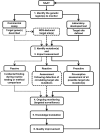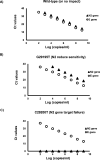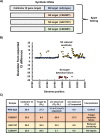Neglected SARS-CoV-2 variants and potential concerns for molecular diagnostics: a framework for nucleic acid amplification test target site quality assurance
- PMID: 37815347
- PMCID: PMC10715164
- DOI: 10.1128/spectrum.00761-23
Neglected SARS-CoV-2 variants and potential concerns for molecular diagnostics: a framework for nucleic acid amplification test target site quality assurance
Abstract
Molecular tests like polymerase chain reaction were widely used during the COVID-19 pandemic but as the pandemic evolved, so did SARS-CoV-2. This virus acquired mutations, prompting concerns that mutations could compromise molecular test results and be falsely negative. While some manufacturers may have in-house programs for monitoring mutations that could impact their assay performance, it is important to promptly report mutations in circulating viral strains that could adversely impact a diagnostic test result. However, commercial test target sites are proprietary, making independent monitoring difficult. In this study, SARS-CoV-2 test target sites were sequenced to monitor and assess mutations impact, and 29 novel mutations impacting SARS-CoV-2 detection were identified. This framework for molecular test target site quality assurance could be adapted to any molecular test, ensuring accurate diagnostic test results and disease diagnoses.
Keywords: COVID-19; NAAT; PCR; SARS-CoV-2; genome; mutation; quality; sequence; target; variant.
Conflict of interest statement
The authors declare no conflict of interest.
Figures



References
-
- Safiabadi Tali SH, LeBlanc JJ, Sadiq Z, Oyewunmi OD, Camargo C, Nikpour B, Armanfard N, Sagan SM, Jahanshahi-Anbuhi S. 2021. Tools and techniques for severe acute respiratory syndrome Coronavirus 2 (SARS-CoV-2)/COVID-19 detection. Clin Microbiol Rev 34:e00228-20. doi:10.1128/CMR.00228-20 - DOI - PMC - PubMed
-
- World Health Organization (WHO) . 2021. SARS-CoV-2 variants. Available from: https://www.who.int/en/activities/tracking-SARS-CoV-2-variants/. Retrieved 23 May 2023.
-
- Food and Drug Administration (FDA) . 2022. SARS-CoV-2 Viral Mutations: Impact on COVID-19 Tests. Available from: https://www.fda.gov/medical-devices/coronavirus-covid-19-and-medical-dev.... Retrieved 23 May 2023.
MeSH terms
Supplementary concepts
LinkOut - more resources
Full Text Sources
Medical
Miscellaneous

